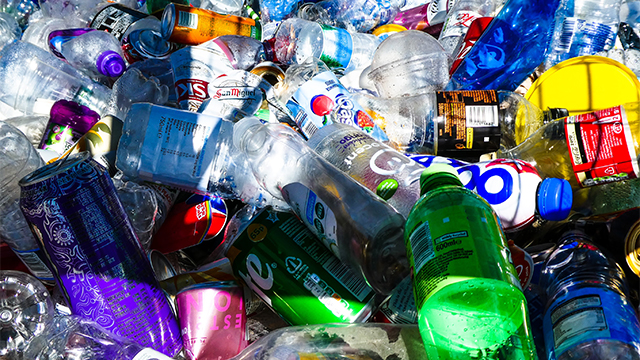Research
Upcyling polyester could reduce plastic waste
March 21, 2022

Called plastic upcycling, efficient use of the chemistry has implications from bioremediation to medicine
Less than 10% of the 380 million metrics tons of annually produced plastics are currently recycled in the U.S., creating a global environmental threat caused by plastic production and the absorption of millions of tons of waste into bodies of water each year. When you look at plastics like polyester, that percentage goes down.
Instead of renewing a commitment to recycling techniques that can only be used once on certain plastics, researchers have looked to other solutions to reduce plastic waste. Plastic upcycling, the process of efficiently deconstructing and rebuilding polymers, which are the essential building blocks of plastic, has become a major area of focus.
Now, a Northwestern University-led team has provided the basis for a technique to enhance the effects of an enzyme that breaks down polyester — the plastic used to make soda bottles and inexpensive clothing (and commercially termed PET) — into its fundamental parts, a development that could help engineers develop solutions for removing microplastics from rivers and oceans.
Their findings were published on March 21 in the journal Proceedings of the National Academy of Sciences (PNAS) and will drive breakthroughs in biotechnology, bioremediation and medicine.

Northwestern’s Monica Olvera de la Cruz, the senior author of the paper, explained that in recycling, plastic is heated up, broken down and then rebuilt into weaker, poorer quality plastics. But in upcycling, breaking down polymers into their fundamental components sometimes allows them to become even sturdier plastics than they were before.
Olvera de la Cruz’s team hoped to create as green an upcycling process as possible; one that didn’t create pollutants but instead removed them. Using an enzyme that can be synthesized in a lab, the researchers developed a process without using other solvents that can be used repeatedly.
“People have discovered an enzyme — a bacteria that eats polyester to survive and converts it into monomeric units,” Olvera de la Cruz said. “But they haven’t been able to use it because it breaks down at a certain temperature. Our idea was to build polymers capable of encapsulating the enzyme to protect its structure, so that it can continue to function outside of living cells and in the lab at sufficiently high temperatures to be able to break down PET.”
In the study, the team designed a polymer and the conditions needed to effectively protect the enzyme (called PETase), so that when the structure was heated, the PETase wouldn’t unravel and become ineffective. The polymer consists of a hydrophobic (water repelling) backbone and highly specific concentrations of its three components, calculated by first author and Ph.D. student Curt Waltmann, to specifically interact with active sites on the enzyme.
Waltmann found that too much negative charge in the polymer meant the enzyme would dissolve in the water, and the polymer would not cover enough of the enzyme surface to protect it. He had to be careful also not to put too many hydrophobic components into the polymer such that the polymer wouldn’t wrap into itself instead of wrapping around the PETase surface.
After the polymer was synthesized using a technique called free radical polymerization, which rapidly links monomers together, it was mixed with chemically synthesized enzymes.
“We found that if you put the complex of the polymer with the enzyme together, and close to a plastic, and then you heat it up slightly, the enzyme was able to break it down into small, monomeric units,” Olvera de la Cruz said. “In addition to operating in an environment like where it could clean microplastics, our method has protected against high temperature degradation, and one student was able to do the testing.”
By finding a way to protect the enzyme from heat, the team opened many doors for the research community. The team has its sights set on encapsulating entire microplastics in the structure, then making an aggregate of microplastics with these enzymes.
The U.S. Department of Energy has an initiative to fund polymer upcycling projects that would reduce plastic waste, and Olvera de la Cruz says her project will contribute to moving the initiative forward.
“You can make a new polymer with the monomeric units,” Olvera de la Cruz said. “These are dangerous things that are bad for our health. We don’t need to make more. You can reuse the ones already here to make an equally good plastic — or better.”
Olvera de la Cruz is the Lawyer Taylor Professor of Materials Science and Engineering, Chemistry and Chemical and Biological Engineering, Physics and Astronomy, director of the Center for Computation and Theory of Soft Materials, and an affiliated faculty member of the International Institute for Nanotechnology.
In addition to Olvera de la Cruz and Waltmann, Northwestern researchers include Carolyn Mills, Jeremy Wang, Baofu Qiao, John Torkelson and Danielle Tullman-Ercek.
The paper, “Functional Enzyme-Polymer Complexes,” was supported by the U.S. Department of Energy, Office of Basic Energy Sciences (Contract DE-FG02-08ER46539).